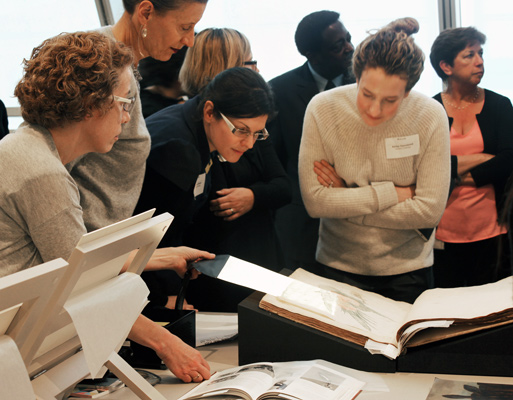French artist Jean-Baptiste Oudry (1686–1755) was perhaps the greatest animal artist of the 18th century, but his talent and range encompassed much more: history subjects, portraits, landscapes, still-lifes, and hunting scenes, among other genres. Trained as a portrait painter, Oudry was received as a history painter at the Royal Academy in Paris in 1719, before going on to specialize in the depiction of animals. Beyond his role as a painter, he also served as director of a royal manufacture (the tapestry manufacture at Beauvais) and as a professor at the academy.
A recent event in our Art Study Center brought together a distinguished group of graduate students, faculty, curators, conservators, and other scholars to engage in an object-based conversation about Oudry. The goal was to delve into the drawing practices of this artist, who—unlike other leading painters of the era, such as Watteau, Chardin, Boucher, and Fragonard—has not received the scholarly and curatorial attention that he deserves. Using the combined holdings of the Harvard Art Museums and The Horvitz Collection of Boston (which generously lent several works for the event), the group discussed various aspects of the artist’s graphic practice.
Several questions animated the day’s proceedings: How did Oudry draw and why? How did he meet the graphic challenge of representing animals as varied as stags, wolves, dromedaries, and exotic birds? To what extent did his draftsmanship relate to his practice as a painter and tapestry designer? Discussion also touched upon the connection between Oudry’s works and the printmaking medium, which served to interpret and disseminate his compositions far and wide, well into the 19th century.
A highlight of the day was the viewing of Oudry’s fascinating album of 96 drawings of exotic birds, part of the museums’ collections. Hal Opperman, emeritus professor at the University of Washington, in Seattle, and a leading authority on Oudry, guided the analysis of this complicated object, which presents more questions than answers: namely, why were these drawings made, and how? They were likely meant to serve as a source for Oudry’s compositions; but instead of being direct studies from nature (which one might expect from a leading animal artist), the watercolors of birds are highly culturally mediated. They seem to rely on a variety of sources, possibly including objects in the French royal collection that had been imported from East Asia. The album also raises questions of attribution, for some of the drawings are not by Oudry, but more likely by his workshop.
Events such as this study day epitomize the important role of a university museum. The hope is to generate fruitful conversations—and passions—that will benefit from further inquiry, sparking new approaches to the study of art here and elsewhere.
This event was organized thanks to the generous support of the Stanley H. Durwood Foundation.
Edouard Kopp is the Maida and George Abrams Associate Curator of Drawings at the Harvard Art Museums.




